#James VanDerZee
Text

Evening Attire
Photography by James VanDerZee
gelatin silver print, 1922
#James VanDerZee#art#artist#photography#Evening Attire#gelatin silver print 1922#Photography by James VanDerZee#beautiful
271 notes
·
View notes
Text

James VanDerZee by Jean Michel Basquiat
"VNDRZ", circa early 1980s
5 notes
·
View notes
Photo
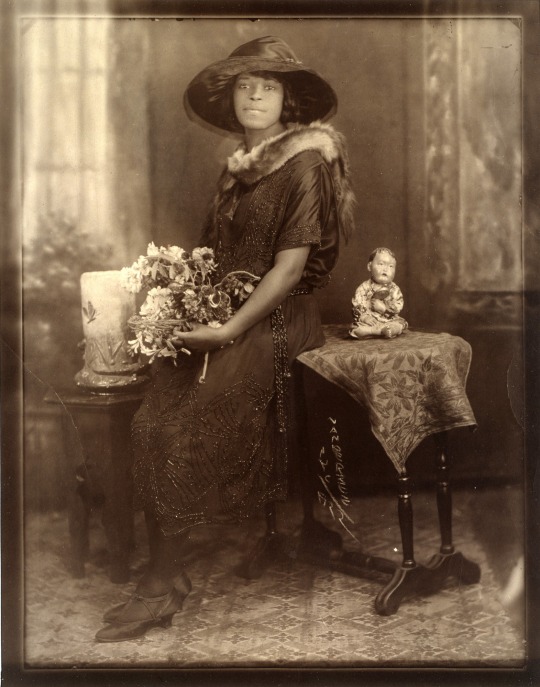
‘Evening Attire’ (1922) by James VanDerZee.
Gelatin silver print.
Image and text information courtesy Smithsonian American Art Museum.
86 notes
·
View notes
Text
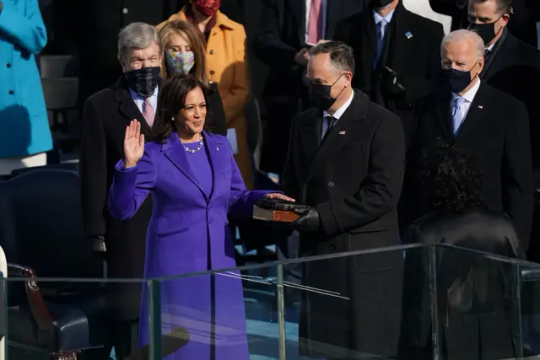
After reading "picturing us" by Deborah willis, I found that she is proud to be black presents black pride and values achievements in that African American culture. So I believed that this picture of Kamala Harris taken from the New York times by Erin Schaff, the first women and first women of color that as been sworn into office is a big representation of a culture achievement and stands with this quote stated by Deborah willis: " Raccoon couple perfectly symbolized, in my mind, the celebration of black life and economic and culture achievement". "Raccoon couple" was a picture taken by James Vanderzee. And I think both pictures represent a Black achievement.
(Willis reading response)
0 notes
Text
This photo is named, "Black jews, Harlem" taken by James VanDerZee. In this photograph, VanDerZee is capturing the diversity of religions within Harlem as well as displaying a impression of power within numbers. The subjects of this piece are assumed to have relations with one another from how close they are standing next to each other. Similar to VanDerZee's other works this photograph is empowering and individual. VanDerZee unveils the rejected side of Harlem embracing it's beauty of his own community and race. This photo is assumed to be taken by a wide lens and the light from the sun is the brightness of this photograph. Since this photo is taken during the Harlem Renaissance it's a perfect parallel of what Deborah Willis was intrigued by in another one of VanDerZee's work, Raccoon Couple in car.

0 notes
Text
“The dances, the rent parties, the plays, the musicians, and the numbers. VanDerZee empowered his subjects for posterity. During that period Harlem was struggling and surviving during the Depression years. His photographs broke the stereotype of Harlem during the Depression, and seeing the exhibition in 1969 made me want to recover the personalities captured within his frame.” - Deborah Willis

This photograph is called “Beau of the Ball”, taken by James VanDerZee. In the 1920s and 1930s during the Great Depression and Harlem Renaissance, James VanDerZee captured the beauty and glamour of his subjects through family portraits and personal portraits. The work of James VanDerZee represents the innovations, art, and culture of Black Americans during this time period. Throughout the struggles of the Great Depression VanDerZee still was able to portray people in modern and fashionable clothing, hairstyles, homes, cars, as well as lifestyles. This image is authentic to the time period and the cultural impact of the Harlem Renaissance, signed by James VanDerZee in 1926. The person in this image is wearing a beautiful fur coat and gown, the style from the 1920s is very iconic and inspirational.
0 notes
Text
Lorna Simpson
In September of 2021, Lorna Simpson unveiled her exhibition, Everrrything at the Hauser and Wirth gallery in Los Angeles. This series combined sculpture, paintings and collages made in 2021 to encapsulate “ layers of paradoxes, threading dichotomies of figurat on and abstraction, past and present, destruction and creation. Collages on view continue the artist’s ongoing exploration of the medium through her appropriation and reimagining of imagery from vintage issues of Ebony and Jet magazines, which have been integral sources for Simpson over the last decade.” Not only was this one of her first pieces since the pandemic, but Simpson made the pieces themselves during the start of the Coronavirus pandemic. In an interview with Shirley Nwangwa for T Magizine, Simpson explained that, “The political and emotional toll of the pandemic has brought me to a place of pulling back from everything. It took me a while to get back into working every day [...]It’s about thinking about things. I’ll wake up from a dream imagining things. So my intellectual and emotional relationship to what I’m doing doesn’t always happen in the studio.” Specifically, this show is a testament to Simpson creating despite the pandemic. This gives a glimpse into her thought process and how things flow and how they exist within her daily life.
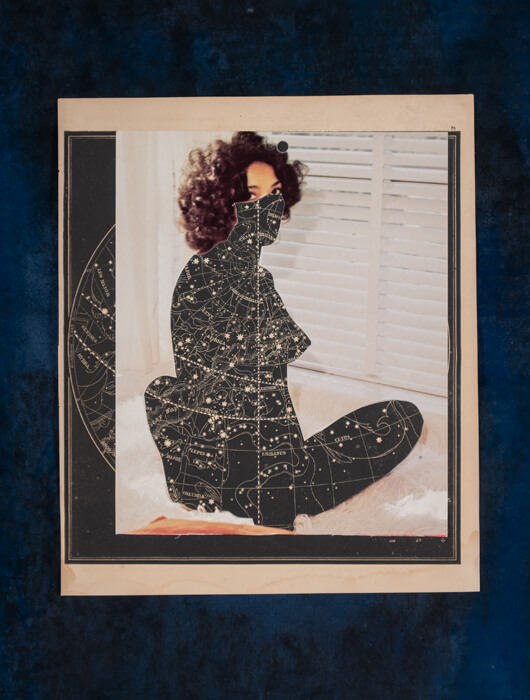

Everrrything features 10 collages and pastel on handmade paper, each are framed. While each piece is included in the series as a whole and not distinguished as the individual, Simpson is able to encapsulate the idea in the series as the woman as the world. Simpson slices various women particularly so their bodies become new landscapes. Only the hair and the eyes or upper portion of the face are depicted in the photos. In these two examples we see women in more intimate positions and framing, but their bodies are instead replaced by a map of the galaxy. Simpson justified these framings by explaining in the New York Times, “ I kept the subject’s eyes to represent the masks we wear outside. But the original environment is supplanted with the galaxy. The galaxy has more to do with endlessness, instead of the narrowness that a pinup suggests.” In This sense Simpson is reclaiming these pin ups of black women and framing them in what she is considering to being the endlesness of the universe. Showing that in a sense, these women are everything, no pun intended. This isn’t unique to this collection, since Simpson has showcased a few collage works that hinge upon Black women where their bodies are replaced by images of the Earth, or their hair is replaced by something materialistic within the Earth such as crystals. These shifts in viewing create a reclamation of personhood and space.


Lorna Simpson 9 props was initially created in 1995. A waterless litograph displayed on wool felt panels. Simpson photographed vases and bowls instead of people. This exhibition ran in The MET in 1998 and was inspired by Harlem photographer James VanDerZee who took similar portraits of items in the 1920s, 30s and 80s. She replicated the objects from his series in glass and in her take has text under each of her photographs which describes the portrait she’s recreating and ending on the object she has recreated and photographed in her own work. To hone in on Benny Andrews she creates a vase that was in the original photo, but begins with a description of the portrait of the artist as seen by James VanDerZee in contrast in Reclining Nude she describes a woman lounging, nude and recreates the vase said to be upside down in the photo. The vase itself in Simpson’s rendition, however, is upright.
While Everrrything and 9 Props have about 26 years and a pandemic between them both home this idea of repurposing work. In 9 Props it’s more metaphorical, with its representations of the work of another artist. In this case Simpson is taking portraits done by VanDerZee and honing in on object aspects that otherwise are not the focal point of the work. She then flips it on its head by honing in on the object and using that to engage the portraiture and also bring attention to VanDerZee’s work. In Everrrything, Simpson looks more to the literal by repurposing old magazine photos and the galaxy to create a new perception of these pin up photos of Black women. While both projects have a different way of repurposing, Simpson utilizes different mediums in each. In 9 Props, she utilizes making the glass vases as well as photographing them in black and white, similar to how the original photos were taken. Everrrything utilizes colors in the photos of the models while the galaxy itself is black and white. Each are unique, but showcase Simpson’s determination to showcase representation and similar themes of identity signature to her work.
Lorna Simpson is best described as “an interdisciplinary artist,”As head of photographs at Phillips in New York Sarah Krueger describes Simpson works on a variety of “mediums in a really creative way, while holding onto her core central themes of memory and identity and representation with her race and her being a woman.” Krueger continued: “In the 1980s, even though she is a multidisciplinary artist, the core of her work was very much photographic. It also coincided with the building of the [contemporary] art market, too.” A lot of Simpson’s work have to do with identity and personhood and I think her exploration of different formats to get her messages across creates power within as it showcases the amount of thought and precision that come into these representations and care within representing artists and communities.
Bibliography
American, Lorna Simpson. “Lorna Simpson: 9 Props.” The Metropolitan Museum of Art, 1 Jan. 1995, https://www.metmuseum.org/art/collection/search/490687.
Boone, Emilie. “An Ode to James Van Der Zee: Lorna Simpson’s 9 Props.” Chicago Journals , https://www.journals.uchicago.edu/doi/full/10.1086/712771.
“Lorna Simpson Everrrything.” Hauser & Wirth, 6 Apr. 2022, https://www.hauserwirth.com/hauser-wirth-exhibitions/33810-lorna-simpson-2/.
Nwangwa, Shirley Ngozi. “The Many Layers of Lorna Simpson.” The New York Times, The New York Times, 30 Sept. 2021, https://www.nytimes.com/2021/09/30/t-magazine/lorna-simpson-art.html
-Kaya Trefz
0 notes
Text

Gabby Bates
Deborah Willis states that James Vanderzee's photograph Raccoon Couple in Car "perfectly symbolized, in [her] mind, the celebration of black life and economic and cultural achievement". Willis continues to applaud Vanderzee’s work because his images broke the negative economic stereotypes about Black Americans in Harlem during the Depression. After reading this part from Picturing Us, I immediately ran to my family's now (partially) digitized family archive of photographs. My great-grandmother Alethea Bugg Jordan Wells was a spirited and independent woman that loved to travel. “Nana”, as I knew her by, was born in March of 1917 in Wetumpka, Alabama. One thing that she loved to do was travel, and one of the many places she visited was Niagara Falls in Ontario, Canada. She is pictured in a patterned blouse, an elegant blazer trench coat, an asymmetrical striped hat, gloves, holding a small purse, and a rose pinned to her coat. These are clothing pieces and accessories that I associate with pride and accomplishment. Her resting pose on the railing even radiates a feeling of regency and importance as she looks out towards the distance. This photograph may not have been taken in Harlem, or exactly around the time of the Depression, but it does relate to Vanderzee's composition and purpose. Both photographs showcase an untold story within the Black community at the time and are used to dismantle harmful stereotypes. I chose this image because I also believe the picture of my great-grandmother is another example of black celebration and economic achievement.
0 notes
Photo
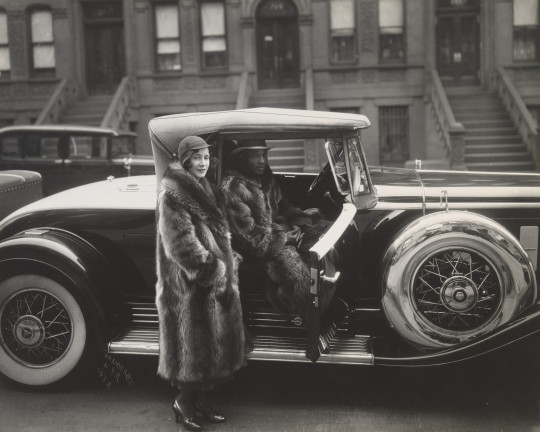
“As I looked at the photograph, I romanticized this period in history through VanDerZee’s portrayal of the couple. In the stories, I Heard about it while I was growing up, Harlem was a source of pride.”
I think these two photos match one of Willis' excerpts and the scenes he depicts. First of all, it mentions Harlem, a place that is known internationally as the Black Mecca of the world, where a lot of great black culture has come out of the area. Over time, in the 1920s, Harlem's culture and artistic expression flourished. This period was named the "Harlem Renaissance".
James Vanderzee, a black photographer, is also the photographer mentioned above. I looked through the photographs of this black photographer and his carefully composed, cosmopolitan photographs convey the personality, aspirations, and spirit of his models. His work provides a glimpse into the rich social life of Harlem as it became an influential center of American culture during the Harlem Renaissance. In this photograph, Vanderzee depicts the prosperity achieved by the blacks living in Harlem. A couple in coonskin coats can be seen in the picture proudly posing with their shiny Cadillacs in front of a row of brown sandstones in Harlem all reflecting the prosperity of Harlem. This picture was created during the Great Depression, but his picture never shows the down-and-out side of the city, breaking down the perception of the depressed state of life during the Great Depression. The portrait also depicts the pride of black Americans in succeeding in spite of systematic injustice.
References:
James Van Der Zee, Couple, Harlem 1932
https://www.moma.org/collection/works/180240
0 notes
Photo

Henrietta Vinton Davis on front steps of the Negro World Newspaper in Harlem, 1924. She was part of delegation presenting petitions to President Coolidge asking for his cooperation in helping to establish a homeland for African-Americans.
Photo: James VanDerZee via Henrietta Vinton Davis's Weblog
#New York#NYC#vintage New York#1920s#James VanDerZee#Harlem#Henrietta Vinton Davis#vintage Harlem#Negro World Newspaper#African Communities League
117 notes
·
View notes
Text
Monday Photography Inspiration - James VanDerZee
Monday Photography Inspiration – James VanDerZee
“Somebody would come in and say, “I never take a good picture”. I’d say, Why not? You’ve got two eyes, a nose, and a mouth like everybody else.” – James VanDerZee
James Van Der Zee was an American photographer was born in Lenox, Massachusetts in 1886. He was known to have produced the most comprehensive documentation of the period. Among his most famous subjects during this time were Marcus…

View On WordPress
#African American photographer#black and white photography#black photographer#inspiration#inspiration of the week#inspirational photographers#inspirations#inspiring photographers#James VanDerZee#Monday inspirations#monday&039;s inspiration#photography art inspiration#photography inspirations
6 notes
·
View notes
Text

Portrait of a Woman
Photography by James VanDerZee
1932
#James VanDerZee#art#artist#photography#Portrait of a Woman#beautiful#Photography by James VanDerZee
33 notes
·
View notes
Photo

In 1916, James VanDerZee opened the Guarantee Photo Studio in New York City’s Harlem neighborhood, and it went on to become the “go-to” portrait studio for many Harlem residents. VanDerZee’s pictures both in out and his studio captured the stories of the changing neighborhood, the joys of family, and the emotions and dreams of the people he photographed. This picture was taken in his own home. The photographer stands next to his wife, Gaynella, who holds one of her deeply loved cats. Around them are walls almost entirely covered with artwork—mostly photographs by VanDerZee himself—and objects that tell us about the comforts of home as well as the success of the couple’s photography business.
"Self-Portrait with Gaynella," 1954, by James VanDerZee © Donna Mussenden Van Der Zee
#Self-Portrait with Gaynella#james vanderzee#african american art#african american artist#photography#art#art museum#philadelphia#philadelphia art museum#philamuseum#philadelphia museum of art#philly art museum#philly museum#philly
54 notes
·
View notes
Video
youtube
Watch “VMFA Spotlights Photographer Louis Draper” on YouTube This is a picture of my Dad Edward Gordon Palmer taken in the mid 1930s by famed Harlem photographer James Van Der Zee.
2 notes
·
View notes
Photo
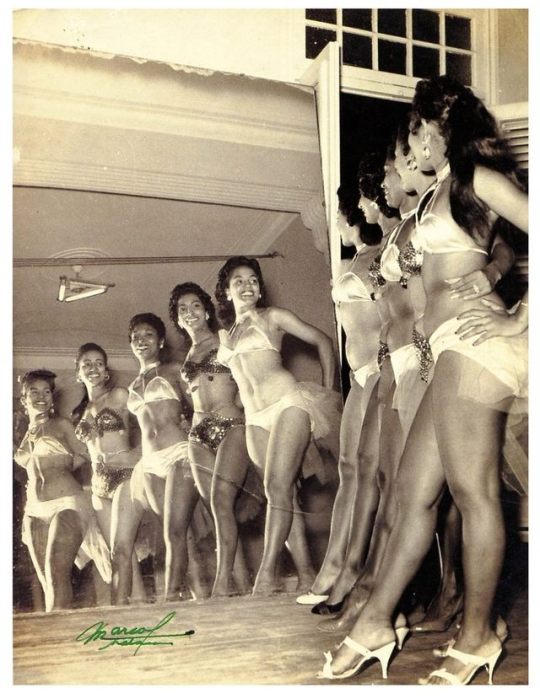
double your pleasure, nightclub showgirls. James Van Der Zee —
12 notes
·
View notes
Photo

James Vanderzee MOMA
Baptism 1927
https://www.moma.org/collection/works/51848?artist_id=6074&page=1&sov_referrer=artist
68 notes
·
View notes